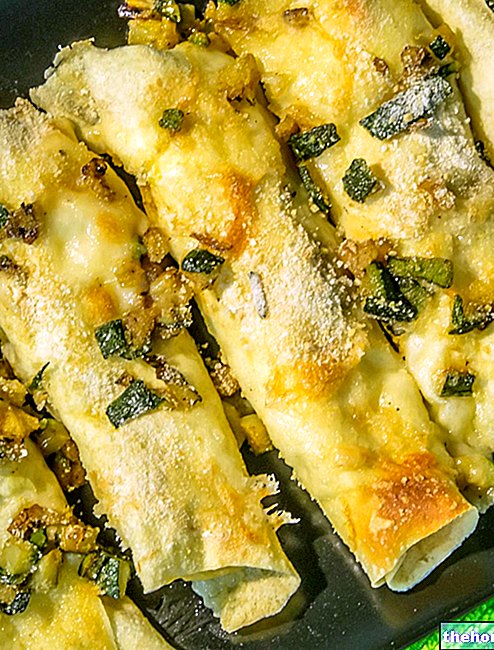I've always wondered how it was possible to make the Rusks with the spiral design, you know, right? Crunchy bicolor slices, with a pleasantly sweet aftertaste. In the morning, that spiral makes me dizzy and now I want to make you dizzy too! Let's prepare the rusks with barley malt together!
Video of the Recipe
Problems with playing the video? Reload the video from youtube.
Identity Card of the Recipe
-
Ingrediants
For the neutral base
- 230 g of Manitoba flour
- 100 ml of water
- 20 ml of extra virgin olive oil
- 50 g of barley malt
- 2 g of dried brewer's yeast
- 3 g of salt
To brush
- 20 ml of soy milk
- 1 pinch of turmeric
For the base with barley
- 2 g of dried brewer's yeast
- 3 g of salt
- 20 ml of extra virgin olive oil
- 40 g of barley malt
- 10 g of soluble barley
- 75 ml of soy milk
- 170 g of Manitoba flour
Materials Needed
- Bowls
- Loaf pan with dimensions of 30 x 10 x 10 cm
- Baking paper
- Brush
- Sieve
- Saw knife
- Baking plate
- Baking paper
- Transparent film
Preparation
- Start with the preparation of the "neutral" dough. In a bowl, sift the Manitoba flour and add the dry yeast. Warm about 50 ml of water and dissolve the barley malt in it. Pour the liquid thus obtained into the center of the flour, together with the remaining cold water.
The alternatives ok
As an alternative to dry brewer's yeast, it is possible to use 5 g of fresh brewer's yeast or sourdough (in doses equal to 30% of the weight of the flour).- Combine the oil with the rest of the ingredients, then knead quickly. Finally add the salt and continue to work the dough for a long time, until the mixture is soft and velvety, without lumps.
- Place the dough in the bowl, cover with cling film and leave to rise in a warm environment for 2 hours or more, until the dough is swollen and doubled in volume.
- In the meantime, devote yourself to preparing the dough with barley. In a bowl, sift the organic Manitoba flour and mix with the dry yeast. Dissolve the barley soluble in vegetable milk (eg soy milk) warm, sweetened with barley malt. Pour the mixture thus obtained into the flour and start kneading, adding the oil first, then the salt. Thus obtaining a soft dough, with a velvety consistency. Place the dough in a bowl and leave to rise in a warm environment until doubled in volume.
The ideal leavening environment
To facilitate leavening, we recommend letting the dough rest in a warm environment, such as an oven heated to 180 ° C for 2 minutes, but turned off. Alternatively, leave the oven light on.- Line a plum cake mold (dimensions: 30 x 10 x 10 cm) with baking paper: to facilitate the adhesion of the baking paper to the mold, it is advisable to brush the walls with a drop of oil and then glue them strips of parchment paper about the same size as the pan.
- When both doughs have risen, proceed with shaping the dough.
- Roll out the neutral dough to form a rectangle that has a side equal to the length of the mold and a thickness of 4-5 mm.
- Then roll out the pasta with the barley until it forms a rectangle that has the same thickness as the previous one, but smaller in size.
- Place the smaller rectangle on the larger one and roll the two pastas to form a sausage. Place the roll obtained in the mold.
The advice OK
To make the two sheets of pasta adhere better, it is advisable to brush the neutral pasta with a drop of oil before placing the one with the barley on it.- Let it rest again in a warm environment for 1 hour and a half or until the dough comes out of the mold.
- Preheat the oven to 180 ° C.
- Dissolve a teaspoon of turmeric in vegetable milk, mix and brush the surface of the pan-brioches with this solution. Cook at 180 ° C (static function) for 30 minutes.
- Remove from the oven and leave to rest on a wire rack for a day.
- After 24 hours of rest, cut the brioches into 4-5 mm thick slices: you will get about 25-30 slices.
- Arrange the slices on a baking sheet and toast at 140 ° C for 15-20 minutes, turning them often during cooking (you can use the oven grill function).
- Allow the rusks to cool, then serve or store on a tin box for a week.
Alice's comment - PersonalCooker
Eating them in the morning is an excellent, healthy and nutritious habit to start the day with determination. Try them with barley malt or jam and soak them in tea or barley: a delight!Nutritional values and Health Comment on the recipe
ATTENTION! Due to the lack of data referring to the nutritional composition of certain ingredients, it is not possible to establish with certainty the chemical values of the recipe.
Barley Malt Rusks should be a food with a rather high energy intake, with a caloric prevalence attributable to carbohydrates (complex and semi-complex), followed by lipids and finally proteins (of medium biological value). Fatty acids should be predominantly unsaturated, cholesterol absent and fiber enough present.
Although of better quality than commercial products, Barley Malt Rusks are unsuitable foods for the diet of overweight subjects, those suffering from type 2 diabetes mellitus and / or hypertriglyceridemia. Furthermore, they must be excluded from the diet against celiac disease, while they are allowed in the diet of the lactose intolerant, vegetarian and vegan.
The average portion should be around 25-30g (75-90kcal).























-nelle-carni-di-maiale.jpg)




